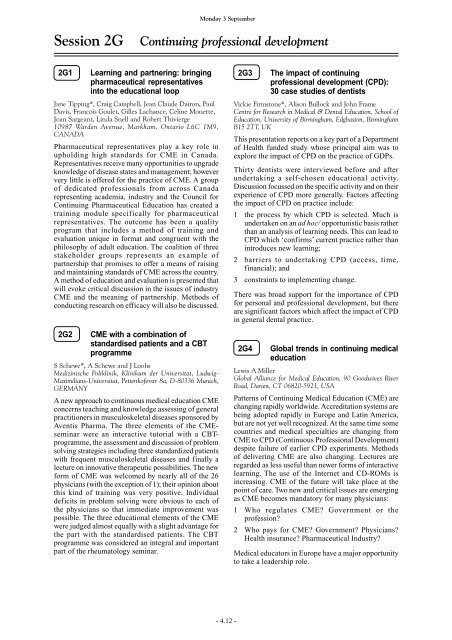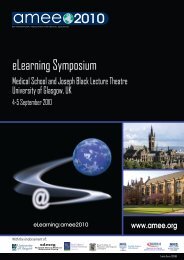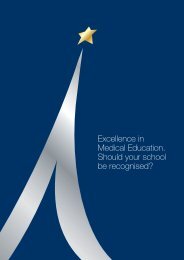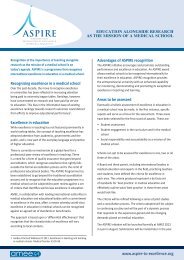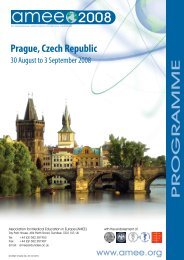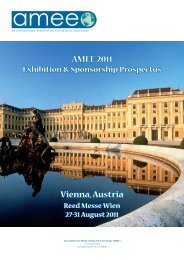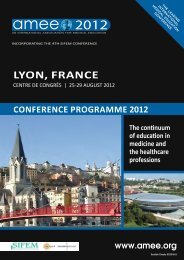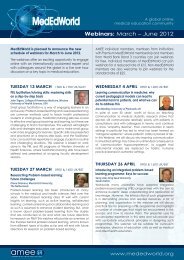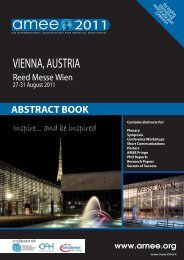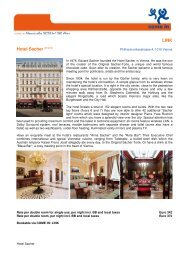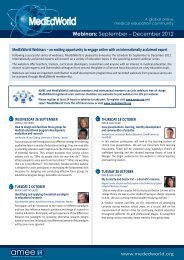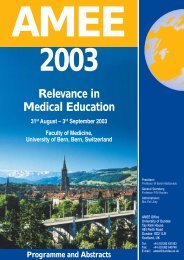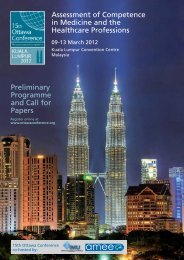AMEE Berlin 2002 Programme
AMEE Berlin 2002 Programme
AMEE Berlin 2002 Programme
You also want an ePaper? Increase the reach of your titles
YUMPU automatically turns print PDFs into web optimized ePapers that Google loves.
Session 2G Continuing professional development<br />
2G1 Learning and partnering: bringing<br />
pharmaceutical representatives<br />
into the educational loop<br />
Jane Tipping*, Craig Campbell, Jean Claude Dairon, Paul<br />
Davis, Francois Goulet, Gilles Lachance, Celine Monette,<br />
Joan Sargeant, Linda Snell and Robert Thivierge<br />
10987 Warden Avenue, Markham, Ontario L6C 1M9,<br />
CANADA<br />
Pharmaceutical representatives play a key role in<br />
upholding high standards for CME in Canada.<br />
Representatives receive many opportunities to upgrade<br />
knowledge of disease states and management; however<br />
very little is offered for the practice of CME. A group<br />
of dedicated professionals from across Canada<br />
representing academia, industry and the Council for<br />
Continuing Pharmaceutical Education has created a<br />
training module specifically for pharmaceutical<br />
representatives. The outcome has been a quality<br />
program that includes a method of training and<br />
evaluation unique in format and congruent with the<br />
philosophy of adult education. The coalition of three<br />
stakeholder groups represents an example of<br />
partnership that promises to offer a means of raising<br />
and maintaining standards of CME across the country.<br />
A method of education and evaluation is presented that<br />
will evoke critical discussion in the issues of industry<br />
CME and the meaning of partnership. Methods of<br />
conducting research on efficacy will also be discussed.<br />
2G2 CME with a combination of<br />
standardised patients and a CBT<br />
programme<br />
S Schewe*, A Schewe and J Loohs<br />
Medizinische Poliklinik, Klinikum der Universitat, Ludwig-<br />
Maximilians-Universitat, Pettenkoferstr 8a, D-80336 Munich,<br />
GERMANY<br />
A new approach to continuous medical education CME<br />
concerns teaching and knowledge assessing of general<br />
practitioners in musculoskeletal diseases sponsored by<br />
Aventis Pharma. The three elements of the CMEseminar<br />
were an interactive tutorial with a CBTprogramme,<br />
the assessment and discussion of problem<br />
solving strategies including three standardized patients<br />
with frequent musculoskeletal diseases and finally a<br />
lecture on innovative therapeutic possibilities. The new<br />
form of CME was welcomed by nearly all of the 26<br />
physicians (with the exception of 1); their opinion about<br />
this kind of training was very positive. Individual<br />
deficits in problem solving were obvious to each of<br />
the physicians so that immediate improvement was<br />
possible. The three educational elements of the CME<br />
were judged almost equally with a slight advantage for<br />
the part with the standardised patients. The CBT<br />
programme was considered an integral and important<br />
part of the rheumatology seminar.<br />
Monday 3 September<br />
- 4.12 -<br />
2G3 The impact of continuing<br />
professional development (CPD):<br />
30 case studies of dentists<br />
Vickie Firmstone*, Alison Bullock and John Frame<br />
Centre for Research in Medical & Dental Education, School of<br />
Education, University of Birmingham, Edgbaston, Birmingham<br />
B15 2TT, UK<br />
This presentation reports on a key part of a Department<br />
of Health funded study whose principal aim was to<br />
explore the impact of CPD on the practice of GDPs.<br />
Thirty dentists were interviewed before and after<br />
undertaking a self-chosen educational activity.<br />
Discussion focussed on the specific activity and on their<br />
experience of CPD more generally. Factors affecting<br />
the impact of CPD on practice include:<br />
1 the process by which CPD is selected. Much is<br />
undertaken on an ad hoc/ opportunistic basis rather<br />
than an analysis of learning needs. This can lead to<br />
CPD which ‘confirms’ current practice rather than<br />
introduces new learning;<br />
2 barriers to undertaking CPD (access, time,<br />
financial); and<br />
3 constraints to implementing change.<br />
There was broad support for the importance of CPD<br />
for personal and professional development, but there<br />
are significant factors which affect the impact of CPD<br />
in general dental practice.<br />
2G4 Global trends in continuing medical<br />
education<br />
Lewis A Miller<br />
Global Alliance for Medical Education, 90 Goodwives River<br />
Road, Darien, CT 06820-5921, USA<br />
Patterns of Continuing Medical Education (CME) are<br />
changing rapidly worldwide. Accreditation systems are<br />
being adopted rapidly in Europe and Latin America,<br />
but are not yet well recognized. At the same time some<br />
countries and medical specialties are changing from<br />
CME to CPD (Continuous Professional Development)<br />
despite failure of earlier CPD experiments. Methods<br />
of delivering CME are also changing. Lectures are<br />
regarded as less useful than newer forms of interactive<br />
learning. The use of the Internet and CD-ROMs is<br />
increasing. CME of the future will take place at the<br />
point of care. Two new and critical issues are emerging<br />
as CME becomes mandatory for many physicians:<br />
1 Who regulates CME? Government or the<br />
profession?<br />
2 Who pays for CME? Government? Physicians?<br />
Health insurance? Pharmaceutical Industry?<br />
Medical educators in Europe have a major opportunity<br />
to take a leadership role.


